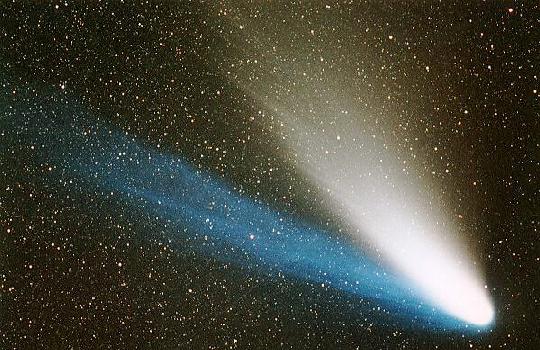Credit & Copyright:
A. Dimai and D. Ghirardo,
(Col Druscie Obs.),
AAC
Explanation:
Today marks the Vernal
Equinox, the first
day of Spring for planet Earth's northern hemisphere.
Despite recent attempts by other
spectacular and
dramatic
celestial events to take center stage,
Comet Hale-Bopp remains the most popular object in the sky
(according to APOD access logs!)
and is likely to make this spring memorable for many.
Gorgeous pictures of the comet with its delightful tails -
this one taken March 16 - make this
outbreak of "comet fever" understandable.
Will the Earth pass through
the lovely tails of Hale-Bopp?
No, but the Earth has made similar journeys in the past.
In fact, tales are often told
of our planet's 1910 passage through comet Halley's tail.
Anticipation of this event caused
hysteria as it followed close on the heels of the spectroscopic
detection of CN, poisonous cyanide, as a gaseous
constituent of cometary tails.
However, stretching for millions of miles, awe-inspiring
comet tails are actually an extremely tenuous, nearly perfect vacuum
and don't pose a danger to
life on Earth.
1999 2000 2001 2002 2003 2004 2005 2006 2007 2008 2009 2010 2011 2012 2013 2014 2015 2016 2017 2018 2019 2020 2021 2022 2023 2024 2025 |
Yanvar' Fevral' Mart Aprel' Mai Iyun' Iyul' Avgust Sentyabr' Oktyabr' Noyabr' Dekabr' |
NASA Web Site Statements, Warnings, and Disclaimers
NASA Official: Jay Norris. Specific rights apply.
A service of: LHEA at NASA / GSFC
& Michigan Tech. U.
|
Publikacii s klyuchevymi slovami:
vesennee ravnodenstvie - kometa Heila-Boppa - kometnye hvosty - kometa Galleya
Publikacii so slovami: vesennee ravnodenstvie - kometa Heila-Boppa - kometnye hvosty - kometa Galleya | |
Sm. takzhe:
Vse publikacii na tu zhe temu >> | |
